|
|
|
|
 |
OTHER MAMMALS: Opossums |
|
|

Identification
An opossum (Didelphis
virginiana) is a whitish or grayish mammal about the
size of a house cat (Fig. 1). Underfur is dense with
sparse guard hairs. Its face is long and pointed, its
ears rounded and hairless. Maximum length is 40 inches
(102 cm); the ratlike tail is slightly less than half
the total length. The tail may be unusually short in
northern opossums due to loss by frostbite. Opossums may
weigh as much as 14 pounds (6.3 kg); males average 6 to
7 pounds (2.7 to 3.2 kg) and females average 4 pounds
(6.3 kg). The skull is usually 3 to 4 inches (8 to 10
cm) long and contains 50 teeth — more than are found in
any other North

Fig. 2. Opossum sign and
characteristics: (a) tracks, (b) droppings, and (c)
skull.
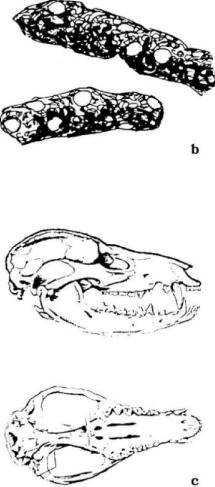 American
mammal. Canine teeth (fangs) are prominent. Tracks of
both front and hind feet look as if they were made by
little hands with widely spread fingers (Fig. 2). They
may be distinguished from raccoon tracks, in which hind
prints appear to be made by little feet. The hind foot
of an opossum looks like a distorted hand. American
mammal. Canine teeth (fangs) are prominent. Tracks of
both front and hind feet look as if they were made by
little hands with widely spread fingers (Fig. 2). They
may be distinguished from raccoon tracks, in which hind
prints appear to be made by little feet. The hind foot
of an opossum looks like a distorted hand.
Fig. 3. Range of the
opossum in North America.
Range

Opossums are found in
eastern, central, and west coast states. Since 1900 they
have expanded their range northward in the eastern
United States. They are absent from the Rockies, most
western plains states, and parts of the northern United
States (Fig. 3).
Habitat
Habitats are diverse,
ranging from arid to moist, wooded to open fields.
Opossums prefer environments near streams or swamps.
They take shelter in burrows of other animals, tree
cavities, brush piles, and other cover. They sometimes
den in attics and garages where they may make a messy
nest.
Food Habits
Foods preferred by
opossums are animal matter, mainly insects or carrion.
Opossums also eat considerable amounts of vegetable
matter, especially fruits and grains. Opossums living
near people may visit compost piles, garbage cans, or
food dishes intended for dogs, cats, and other pets.
General Biology, Reproduction, and Behavior
Opossums usually live
alone, having a home range of 10 to 50 acres (4 to 20
ha). Young appear to roam randomly until they find a
suitable home range. Usually they are active only at
night. The mating season is January to July in warmer
parts of the range but may start a month later and end a
month earlier in northern areas. Opossums may raise 2,
rarely 3, litters per year. The opossum is the only
marsupial in North America. Like other marsupials, the
blind, helpless young develop in a pouch. They are born
13 days after mating. The young, only 1/2 inch (1.3 cm)
long, find their way into the female’s pouch where they
each attach to one of 13 teats. An average of 7 young
are born. They remain in the pouch for 7 to 8 weeks. The
young remain with the mother another 6 to 7 weeks until
weaned.
Most young die during
their first year. Those surviving until spring will
breed in that first year. The maximum age in the wild is
about 7 years.
Although opossums have a
top running speed of only 7 miles per hour (11.3 km/hr),
they are well equipped to escape enemies. They readily
enter burrows and climb trees. When threatened, an
opossum may bare its teeth, growl, hiss, bite, screech,
and exude a smelly, greenish fluid from its anal glands.
If these defenses are not successful, an opossum may
play dead.
When captured or surprised
during daylight, opossums appear stupid and inhibited.
They are surprisingly intelligent, however. They rank
above dogs in some learning and discrimination tests.
Damage
Although opossums may be
considered desirable as game animals, certain
individuals may be a nuisance near homes where they may
get into garbage, bird feeders, or pet food. They may
also destroy poultry, game birds, and their nests.
Legal Status
Laws protecting opossums
vary from state to state. Usually there are open seasons
for hunting or trapping opossums. It is advisable to
contact local wildlife authorities before removing
nuisance animals.
Damage Prevention and Control Methods
Exclusion
Prevent nuisance animals
from entering structures by closing openings to cages
and pens that house poultry. Opossums can be prevented
from climbing over wire mesh fences by installing a
tightly stretched electric fence wire near the top of
the fence 3 inches (8 cm) out from the mesh. Fasten
garbage can lids with a rubber strap.
Traps
Opossums are not wary of
traps and may be easily caught with suitable-sized box
or cage traps (Fig. 4). No. 1 or 1 1/2 leghold traps
also are effective. Set traps along fences or
trail-ways. Dirt hole sets or cubby sets are effective
(Fig. 5). A dirt hole is about 3 inches (8 cm) in
diameter and 8 inches (20 cm) deep. It extends into the
earth at a 45 o angle. The trap should be set at the
entrance to the hole. A cubby is a small enclosure made
of rocks, logs, or a box. The trap is set at the
entrance to the cubby. The purpose of the dirt hole or
cubby is to position the animal so that it will place
its foot on the trap. Place bait such as cheese, or
slightly spoiled meat, fish, or fruit in the dirt hole
or cubby to attract the animal. Using fruit instead of
meat will reduce the chance of catching cats, dogs, or
skunks.
 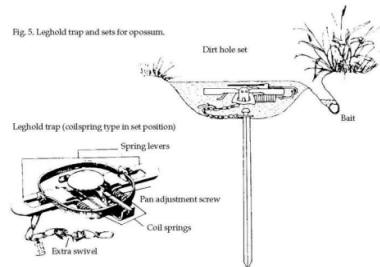
Fig. 4. Cage trap (set position).
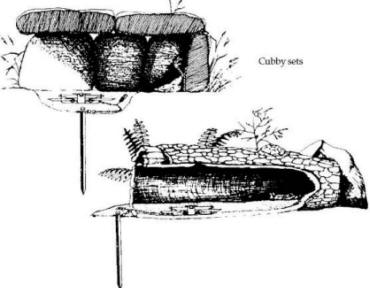
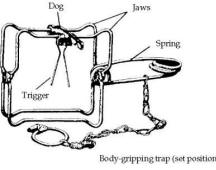
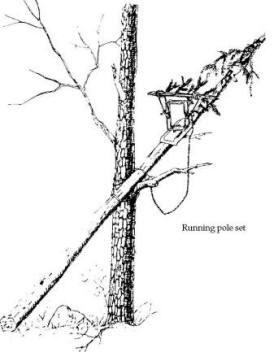
Fig. 6. Body-gripping trap
and running pole set.
A medium-sized
body-gripping (kill type) trap will catch and kill
opossums. Place bait behind the trap in such a way that
the animal must pass through the trap to get it.
Body-gripping traps kill the captured animal quickly. To
reduce chances of catching pets, set the trap above
ground on a running pole (Fig. 6).
Shooting
A rifle of almost any
caliber or a shotgun loaded with No. 6 shot or larger
will effectively kill opossums. Use a light to look for
opossums after dark. If an opossum has not been alarmed,
it will usually pause in the light long enough to allow
an easy shot. Once alarmed, opossums do not run rapidly.
They will usually climb a nearby tree where they can be
located with a light. Chase running opossums on foot or
with a dog. If you lose track, run to the last place
where you saw the animal. Stop and listen for the sound
of claws on bark to locate the tree the animal is
climbing.
Sometimes opossums can be
approached quietly and killed by a strong blow with a
club, but they can be surprisingly hard to kill in this
manner. They can be taken alive by firmly grasping the
end of the tail. If the animal begins to “climb its
tail” to reach your hand, lower the animal until it
touches the ground. This will distract the opossum and
cause it to try to escape by crawling. Opossums can
carry rabies, so wear heavy gloves and be wary of bites.
Euthanize unwanted animals
humanely with carbon dioxide gas, or release them
several miles from the point of capture.
Economics of Damage and Control
No data are available;
however, it is usually worthwhile to remove a particular
animal that is causing damage.
Acknowledgments
Much of the information on
habitat, food habits, and general biology comes from J.
J. McManus (1974) and A. L. Gardner (1982). The
manuscript was read and improved by Jim Byford and
Robert Timm.
Figures 1, 2a, 2c, and 3
from Schwartz and Schwartz (1981).
Figure 2b by Jill Sack
Johnson.
Figures 4, 5, and 6 by
Michael D. Stickney, from the New York Department of
Environmental Conservation publication “Trapping
Furbearers, Student Manual” (1980), by R. Howard, L.
Berchielli, C. Parsons, and M. Brown. The figures are
copyrighted and are used with permission.
For Additional Information
Fitch, H. S., and L. L.
Sandidge. 1953. Ecology of the opossum on a natural area
in northeastern Kansas. Univ. Kansas Publ. Museum Nat.
Hist. 7:305-338.
Gardner, A. L. 1982.
Virginia opossum. Pages 3-36 in J. A. Chapman and G. A.
Feldhamer, eds. Wild mammals of North America: biology,
management, and economics. The Johns Hopkins Univ.
Press, Baltimore, Maryland.
Hall, E. R., and K. R.
Kelson. 1959. The mammals of North America, Vol. 1.
Ronald Press Co., New York. 546 pp.
Hamilton, W. J., Jr. 1958.
Life history and economic relations of the opossum (Didelphis
marsupialis virginiana) in New York State. Cornell Univ.
Agric. Exp. Sta. Memoirs 354:1-48.
Howard, R., L. Berchielli,
C. Parsons, and M. Brown. 1980. Trapping furbearers,
student manual. State of New York, Dep. Environ. Conserv.
59 pp.
Lay, D. W. 1942. Ecology
of the opossum in eastern Texas. J. Mammal. 23:147-159.
McManus, J. J. 1974.
Didelphis virginiana. Mammal. Species 40:1-6.
Reynolds, H. C. 1945. Some
aspects of the life history and ecology of the opossum
in central Missouri. J. Mammal. 26:361-379.
Schwartz, C. W., and E. R.
Schwartz. 1981. The wild mammals of Missouri, rev. ed.
Univ. Missouri Press, Columbia, 356 pp.
Seidensticker, J., M. A.
O’Connell, and A. J. T. Johnsingh. 1987. Virginia
opossum. Pages 246-263 in M. Novak, J. A. Baker, M. E.
Obbard, and B. Malloch, eds. Wild furbearer management
and conservation in North America. Ontario Ministry Nat.
Resour. Toronto.
Editors
Scott E. Hygnstrom, Robert
M. Timm, Gary E. Larson
PREVENTION AND CONTROL OF
WILDLIFE DAMAGE — 1994
Cooperative Extension
Division Institute of Agriculture and Natural Resources
University of Nebraska -Lincoln
United States Department
of Agriculture Animal and Plant Health Inspection
Service Animal Damage Control
Great Plains Agricultural
Council Wildlife Committee
D-64
Special
thanks to:
Clemson University
|